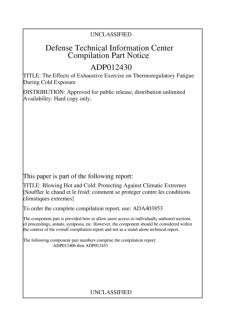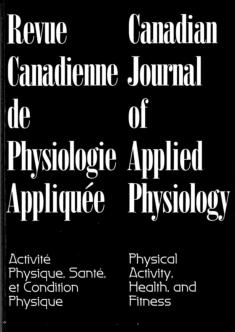Scientific papers 2004 - 2005





Introduction:
Our decompression tradition is based on the principles set
by Haldane in 1908 (1). The classic or “Haldanian” models
used for the calculation of present tables all have the same
mathematical expression: a) they figure inert gas
exchanges with a series of exponential compartments; b)
they specify the safe ascent criteria as a linear relation
between the ambient pressure and the maximum
permitted compartment tension. As a consequence, these
models have produced similar decompression profiles,
characterized by a initial rapid ascent on a relatively high
distance. However, the drive for table development is
operational pressure. Aside the information circuits,
marginal divers’ communities have empirically developed
original decompression procedures for their needs.
Apparently, all share the same strategy and use slower
rates of ascent and deeper stops than would be predicted
by the Haldanian models.
An attempt is made to introduce new assumptions and
build them into a model to obtain the typical profile of
these successful decompressions.



UK HSE reseach report 244. Prepared by Unimed Scientific
Limited for the Health and Safety Executive 2004.
This document is a study of the decompression risks of
saturation diving with particular reference to the risks
which arise from depth changes during the work shifts,
excursions.

This study examined the relationship between thermal
conditions and DCS risk, the production of venous gas
embolism, or inert gas exchange. Also, the authors
conducted a second search for the effects of showering
on DCS and examined the Naval Medical Research
Institute (NMRI) DCS database for cases of DCS
associated with showering. Accepted epidemiological
criteria for the evaluation of causal relationships were
applied to the studies they found on the subject.
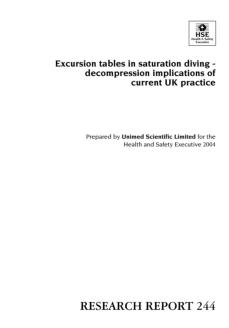
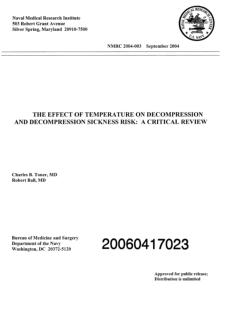

Optimization of oxygen tolerance extension by
intermittent exposure was studied in groups of 20 rats
exposed to systematically varied patterns of alternating
oxygen and normoxic breathing periods at 4.0, 2.0, and
1.5 ATA. Oxygen periods of 20, 60, and 120 min were
alternated with normoxic intervals that provided oxygen-
to-normoxia ratios of 4:1, 2:1, 1:1, and 1:3.
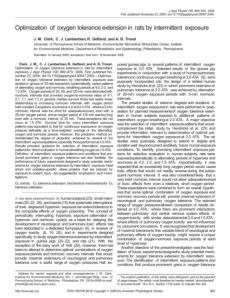

This paper gives a detailed history of the deep-diving
operations and researches undertaken by COMEX.
These operations and studies resulted in the creation of
tables such as those used by the French ministry of labour
and also the NORMAM 15/DPC procedures in Brazil.
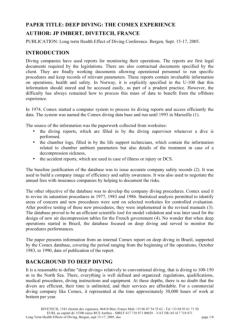

Authors:
Zeljko Dujic, Darko Duplancic , Ivana Marinovic-Terzic,
Darija Bakovc, Vladimir Ivancev, Zoran Valic, Davor
Eterovic, Nadan M Petri, Ulrik Wisløff, and Alf O. Brubakk.
This study is a continuation of previous experiments that
demonstrated that a single bout of high-intensity aerobic
exercise 20 h before a simulated dive reduces bubble
formation and protects rats from decompression sickness.
The present study investigates the importance of these
findings in man.
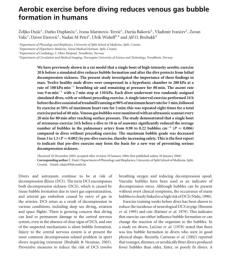

The study's objective was to evaluate the
cardiopulmonary effects of open sea scuba air diving to
39 m (30 minutes bottom time) with standard
decompression. The variables were measured in different
post-dive body postures and compared with the baseline
values before the dive in the same posture to account for
possible gravity-dependent effects of venous gas bubbles.
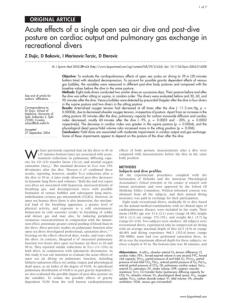

Authors:
H. D. Van Liew & E. T. Flynn
The authors used a graphical approach to compare
prescriptions for ascent given by various air
decompression tables with outcomes of experimental
dives compiled in the U.S. Navy Decompression Database.

Authors:
Z. Dujic, I. Palada, A. Obad, D. Duplancic, D. Bakovic, & Z.
Valic.
Decompression sickness is initiated by the formation of
gas bubbles in tissue and blood if the divers return to
surface pressure too fast. The effect of exercise before,
during, and after dive on bubble formation is still
controversial. The team reported previously that strenuous
aerobic exercise 24 h before simulated dive ameliorates
venous bubble formation. The objective of this field study
was to evaluate whether mild, continuous exercise during
decompression has a similar impact.
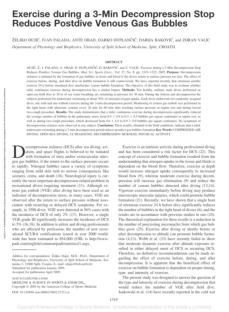

Authors:
Jean-Eric Blatteau, Emmanuel Gempp, Franc¸ois-Michel
Galland, Jean-Michel Pontier, Jean-Marie Sainty, and
Claude Robinet.
A single bout of aerobic exercise 24 h before a dive
significantly reduces the formation of circulating venous
gas emboli (VGE) on decompression. The purpose of this
investigation was to determine the effect of aerobic
exercise 2 h before a dive.
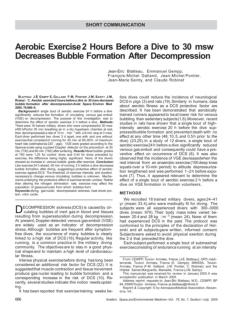

Sixteen U.S. Navy divers began a series of 4-hour dives at
a PO2 of 1.4 atm daily for two consecutive five-day weeks.
Nine divers were able to finish; all withdrawals were for
nonpulmonary reasons. Divers rested on the bottom of a
15-foot freshwater pool and breathe humidified 100%
oxygen open circuit from MK 20 full face masks. Flow-
volume curves and diffusing capacity were measured at
baseline, daily during diving, and after the series.
Symptoms and changes in pulmonary function values
were used to measure pulmonary oxygen toxicity, and
the results were compared to earlier series of similar four-
hour dives.


Authors: David M. Dromsky, Bruce D. Spiess, Andreas
Fahlman.
The authors of this paper examined an adjunctive
treatment for severe decompression sickness (DCS) to be
used when hyperbaric treatment is delayed or
unavailable. It is based on the hypothesis that intravenous
perfluorocarbon (PFC) emulsion combined with 100%
inspired O2 would improve severe DCS outcomes.
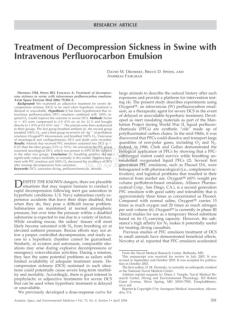

Authors: A. O. Brubakk, D. Duplancic, Z. Valic, I. Palada,
A. Obad, D. Bakovic, U. Wisloff, and Z. Dujic.
During and after decompression from dives, gas bubbles
are regularly observed in the right ventricular outflow
tract. Several studies have documented that these bubbles
can lead to endothelial dysfunction in the pulmonary
artery, but no data exist on the effect of diving on arterial
endothelial function. The present study investigated if
diving or oxygen breathing would influence endothelial
arterial function in man.


Unimed Scientific Limited USL) has carried out a study of
yo-yo diving at the request of the UK Health and Safety
Executive. Yo-yo diving is defined as a series of dives with
short periods spent at depth alternating with similar
periods on the surface. In general, the total duration of
the series is within the time constraints for a single dive to
the same depth for the maximum time allowed without
incurring decompression stops.
.
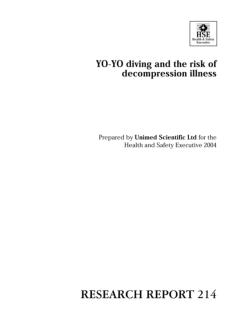

Author: Page R Painter
The maximum metabolic rate (MMR) of mammals is
approximately proportional to M0.9, where M is the
mammal's body weight. Therefore, MMR increases with
body weight faster than the basal metabolic rate (BMR),
which is approximately proportional to M0.7. MMR is
strongly associated with the capacity of the cardiovascular
system to deliver blood to capillaries in the systemic
circulation, but the properties of this vascular system have
not produced an explanation for the scaling of MMR.
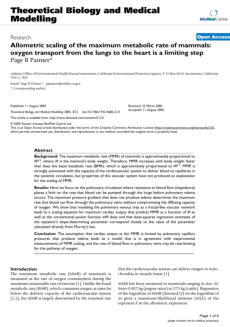

Authors: M. Marczak, & M. Pokorski
The authors investigated the ventilatory response to
normobaric poikilocapnic hyperoxia in healthy subjects.
The study was carried out in 26 subjects aged 26years,
who breathed pure oxygen through a two-way valve for
10 min. Ventilatory flow was recorded using a
pneumotachograph and minute ventilation was
calculated from the tidal and frequency components.



Authors:
A. Marroni , P. B. bennett, F. J. Cronje, R. Cali-Corleo, P.
Germompre , M. Pieri, C. Bonucelli, C. Balestra
This document describes experiments undertaken to verify
the hypothesis that a deep stop would significantly reduce
fast tissue bubble formation and neurological DCS risk. A
total of 181 dives were made to 82 fsw (25 m) by 22
volunteers. The conclusion was that a deep stop
significantly reduced Doppler-detected bubbles and tissue
gas tensions in the 5 and 10 min tissues, which has
implications for reducing the incidence of neurological
DCS in divers.
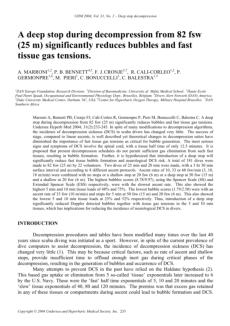

Author: N Bitterman
This document, published in 2015, briefly presents the
knowledge about CNS oxygen toxicity: the clinical
manifestations, descriptions, incidence of symptoms, and
the time duration relationship that defines the safety limits
and risk factors leading to enhanced toxicity to hyperbaric
oxygen. A general outline presents suggested
mechanisms underlying hyperoxia-induced seizures and
strategies for protection against the attacks.


Author: Barbara Shykoff
This document describes experimental four-hour resting
dives while breathing 100% O2 underwater at a
partial pressure of 1.35 atm performed by the US
Navy. Its conclusion is that although even single
four-hour dives at PO2 = 1.35 atm entail some risk
of pulmonary injury, repeated dives with surface
intervals of 20 hours for up to five days do not
appear to be more damaging.
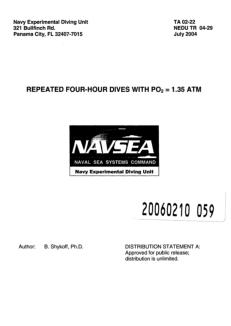

Author: R. Kłos
Research on the validation of decompression tables is one
of the common subject areas of the cooperation
undertaken between the DRDC Toronto, Canada, and
The Naval University of Gdynia, Poland.
A survey of diving technologies has been conducted for
Scientific Research and the Polish Navy. Among the most
critical problems discussed have been various aspects of
decompression safety. The following is a study to
standardize and unify validation procedures for
decompression in the Polish Navy.
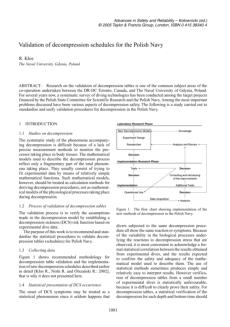

Authors: (R.D Vann, W.A Gerth, P.J Denoble, C.F Pieper, &
E.D Thalmann
The authors conducted experimental trials of flying after
diving using profiles near the no-decompression
exposure limits for recreational diving. The objective was
to determine the dependence of DCS occurrence during
or after flight on the length of the pre-flight surface
intervals (PFSI).
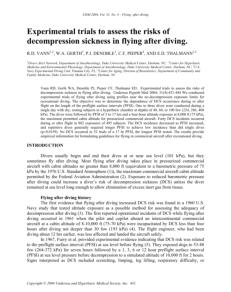

The Brooklyn bridge design was made by John Augustus
Roebling, an architect with a relatively modest experience
in suspended bridge construction. He died few days after
the beginning of the construction work, after stepping on
a cable round and contacting tetanus.
His son, Washington Augustus Roebling, took over the
project management. Unfortunately, as a fire started in the
deepest caisson wooden structure, he spent more than
12 hours at 30 m in the caisson trying to fight the fire and
decompressed without any stop. As he became crippled,
he was forced to stay at his office. He kept controlling the
work with his binoculars while his wife Emily helped him
communicating with the workers. When the bridge was
inaugurated in 1883, Phineas Barnum demonstrated his
strength by crossing the river with the 21 elephants of his
circus.
Very large caissons were employed in the construction of
the Brooklyn Bridge, one of them being sunk to a
maximum depth of 30 m. The working conditions were
dramatic and there were at least 27 fatalities. There was
neither knowledge nor understanding of the
decompression process. Although 110 cases of serious
decompression illness were recorded by the attending
physician, recompression was not used for treatment. It
was on the Brooklyn Bridge project that the word “bends”
was coined for decompression illness. A stilted way of
walking affected by fashionable ladies of the time was
termed “the Grecian Bend”. When the caisson workers
showed signs of decompression illness, their painful
attitude suggested the Grecian Bend. The term was
shortened to “doing the bend” and finally “bends” or
“bent” became legitimized by use.



Authors:
K. Kohshi, R. M. Wong, H. Abe, T. Katoh, T. Okudera, Y,
Mano
Four professional Japanese breath hold divers (Ama) with
histories of diving accidents were reported.
Magnetic resonance imaging of these divers detected
cerebral infarcts localized in the watershed areas of the
brain. A survey conducted on their island revealed that
many Ama divers had experienced stroke-like events. A
clinical feature of DCI in breath hold diving is that the
damage is limited to the brain. Although the mechanisms
of brain damage in BH diving are unclear, N2 bubbles
passing through the lungs or the heart so as to become
arterialized are most likely to be the etiological factor.


Author: John B. West
In 1660, Robert Boyle (1627–1691) published his
landmark book New Experiments Physico-Mechanicall,
Touching the Spring of the Air, and its Effects in which he
described the first controlled experiments of the effects of
reducing the pressure of the air. Critical to this work was
the development of an air pump by Boyle with Robert
Hooke (1635–1703). For the first time, it was possible to
observe physical and physiological processes at both
normal and reduced barometric pressures.
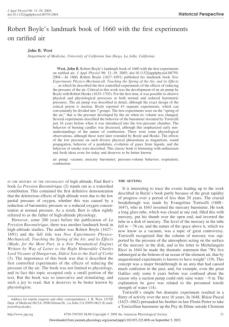

Authors:
Richard A. Neubauer, Virginia Neubauer, & Franz
Gerstenbrand
Controlled studies have demonstrated safety and efficacy
of hyperbaric oxygenation therapy (HBOT) in the
treatment of anoxic, traumatic, ischemic, or thrombotic
brain injury.
Clinical improvements were correlated with increased
perfusion and metabolism, with reactivation of idling
neurons demonstrated by sequential single photon
emission computerized tomographic (SPECT) scanning.
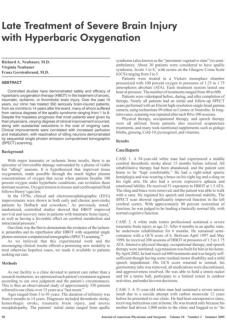

Authors: T. Stensrud, S. Berntsen, K.-H. Carlsen
Exercise-induced bronchoconstriction (EIB) increases in
cold and dry air and decreases in humid air in subjects
with asthma. Few reports have reported on the effect of
humid environment upon exercise capacity in subjects
with EIB.
The primary aim of the present study was to examine the
effect of changing the humidity of the environmental air
upon exercise capacity measured by peak oxygen uptake,
peak ventilation and peak running speed and secondarily
to assess the influence of environmental humidity upon
EIB in subjects suffering from EIB.
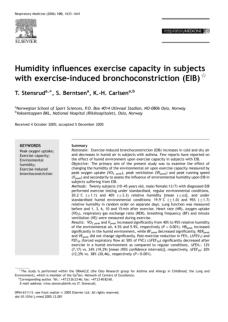

Author: R.W. Hamilton
This paper attempts to show how a variety of
decompression tables, including some that are not “in the
book,” can lead to improved decompression capability.
Such tables are often available from diving training
organizations. They can also be obtained from
decompression specialists, and in some cases, can be
developed by the using organization. Many innovative
table collections are available from specific sources.


Authors: Manfred R. Enstipp, David Grémillet, and Svein-
Håkon Lorentsen
This paper attempts to show how a variety of
decompression tables, including some that are not “in the
book,” can lead to improved decompression capability.
Such tables are often available from diving training
organizations. They can be obtained from decompression
specialists, and in some cases, can be developed by the
using organization. Many innovative table collections are
available from specific sources.
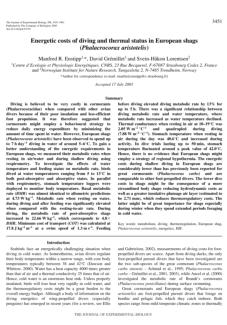

Click on the octopus
to return to the top
of the page



Authors: James T. Webb, Andrew A. Pilmanis, ULF I.
Balldin, Joseph R. Fisher
The US Air Force studied altitude decompression sickness
(DCS) using a database with data from 2980 exposures.
The study involved 240 subjects and found DCS incidence
rates ranging from 5 to 95%. Researchers assessed
susceptibility by examining factors such as height, weight,
age, body fat percentage, and aerobic capacity. Findings
showed that DCS incidence was 46.5% during 1,879
subject exposures. A correlation was found between
lower aerobic capacity and greater weight, higher
susceptibility to DCS, these factors only explain less than
13% of the variation in risk.




Authors:
C.M. Maresh, C.L. Gabaree-Boulant, L. E. Armstrong, D.A.
Judelson, J.R. Hoffman, J.W. Castellani, R.W. Kenefick,
M.F. Bergeron, and D. J. Casa
The authors of this document investigate the impact of
pre-exercise dehydration on thirst and drinking behavior
during exercise in heat-stress conditions. They conclude
that pre-exercise dehydration increases thirst-driven
drinking during exercise in the heat but results in similar
fluid regulatory hormonal responses and plasma volume
changes regardless of initial hydration status.


Authors:
Ulrik Wisløff, Russell S. Richardson, and Alf O. Brubakk
This paper discusses the effects of nitrogen bubbles
forming in the blood when divers ascend too quickly,
which can lead to decompression sickness (DCS), with
symptoms ranging from skin rashes to death. Research
has shown that exercising 20 hours before a dive can
prevent bubble formation and protect against severe DCS
in rats. Additionally, administering a nitric oxide (NO)-
releasing agent either chronically or acutely before a dive
also reduces bubble formation and prevents death.
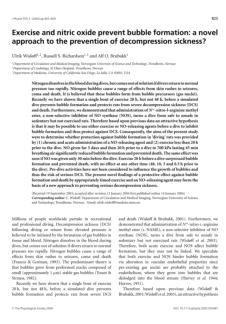

Authors: Jane D. McNeilly, Mathew R. Heal, Iain J.
Beverland, Alan Howe, Mark D. Gibson, Leon R.
Hibbs, William MacNee, & Ken Donaldson
Epidemiological studies have shown that welders exposed
to high concentrations of metal-enriched welding fumes
have a higher incidence of respiratory illnesses such as
bronchitis, metal fume fever (MFF), and chronic
pneumonitis. This study investigated the molecular
toxicology of three metal-rich welding fumes: NIMROD
182, NIMROD c276, and COBSTEL 6. The findings suggest
that soluble transition metal components mediate the pro-
inflammatory responses to welding fumes through
oxidative stress mechanisms.
.
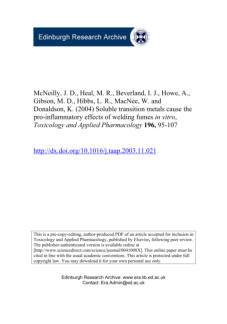

Authors:
R. Arieli, O. Ertracht, I. Oster, A. Vitenstein, and Y. Adir
This study investigates the contentious issue of the impact
of inert gases, specifically nitrogen and helium, on the risk
of central nervous system (CNS) oxygen toxicity.
Researchers examined the latency of the first electrical
discharge (FED) in the electroencephalography (EEG) of
rats exposed to varying nitrogen, helium, and oxygen
pressures. Results showed that nitrogen's effect on latency
was inconsistent among rats, with some experiencing
prolonged latency at certain pressures, while helium
consistently reduced latency.
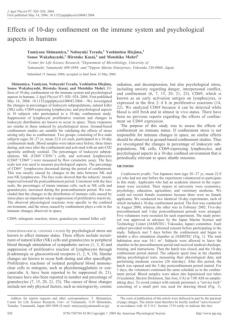

Authors: Tamiyasu Shimamiya, Nobuyuki Terada,
Yoshimitsu Hiejima, Sonoe Wakabayashi,
Hirotake Kasai, and Motohiko Mohri
The authors of this study examined the effects of a 10-day
confinement on leukocyte subpopulations, NK cells,
CD69-expressing lymphocytes, and psychological aspects
in 10 male subjects aged 20–27, divided into two groups.
They used blood sampling and psychological assessments
conducted before, during, and after confinement. They
concluded that stress from confinement affects immune
cell distribution and suppresses lymphocyte proliferative
reactivity.
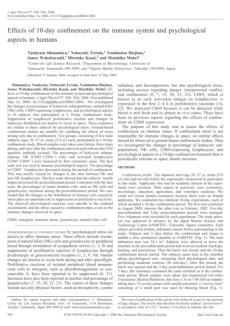

Authors: Stephen J. Cringle and Dao-Yi Yu
This study aimed to assess the retina and choroid's ability
in the rabbit retina's avascular region to regulate
intraretinal oxygen levels during acute systemic hyperoxia.
Researchers used oxygen-sensitive microelectrodes to
measure oxygen tension across the retina and choroid in
anesthetized rabbits before and after incremental
increases in inspired oxygen levels. The findings revealed
that, unlike other mammals, rabbits lack regulatory
mechanisms to control intraretinal oxygen levels during
acute systemic hyperoxia.
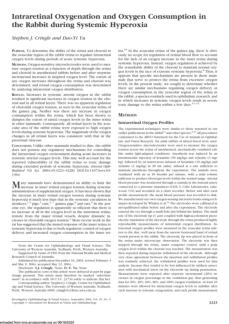

Authors:
Ursula G. Kyle, Ingvar Bosaeus, Antonio D. De Lorenzo,
Paul Deurenberg, Marinos Elia, Jose Manuel Gomez, Berit
Lilienthal Heitmann, Luisa Kent-Smith, Jean-Claude
Melchior, Matthias Pirlich, Hermann Scharfetter, , Annemie
M.W.J. Schols, Claude Pichard
Bioelectrical impedance analysis (BIA) assesses fat-free
mass (FFM), total body water (TBW), and areas of stress.
However, the authors consider that it lacks standardized
methods and quality control. They highlight its
effectiveness with appropriate equations and procedures,
especially in subjects without significant fluid and
electrolyte abnormalities. Therefore, they propose
validated BIA equations and rank them by their standard
error of the estimate.
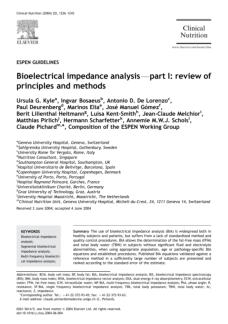

Authors: SM Smith, JE Davis-Street, JV Fesperman, MD
Smith, BL Rice, SR Zwart
A clinical nutritional assessment was conducted on the
NASA Extreme Environment Mission Operation V
(NEEMO) crew before, during, and after a 14-day
saturation dive to study physiological changes related to
space travel. The observed physiological changes
included decreased serum hemoglobin and hematocrit,
increased serum ferritin and ceruloplasmin, and decreased
transferrin receptors. Additionally, there was evidence of
increased oxidative damage and stress, and subjects
experienced decreased energy intake and weight loss.


Authors: A.L Gill & C.N.A. Bell
This review, published in 2004, aimed to clarify HBO and
its potential patient benefits based on the Undersea and
Hyperbaric Medical Society (UHMS), which defines HBO
as a patient breathing 100% oxygen in a pressurized
chamber exceeding sea level pressure (1 atmosphere
absolute, ATA). The review included information from the
UHMS committee report and Medline searches, covering
the history, physiology, current indications, and effects of
HBO therapy.


Authors: Makoto Ikeda , Kazohiko Nakabayashi ,
Masaharu Shinkai , Yukihiko Hara, Takako Kizaki,
Shujiho Huji Oh-Ishi, and Hideki Ohno
There are conflicting views regarding the impact of deep
saturation dives on liver function in divers. Consequently, a
study was conducted to reevaluate whether a deep
saturation dive (400 msw) causes liver disturbances. The
results confirmed liver dysfunction, likely due to oxidative
stress. The effects of antioxidant supplementation were
examined and appeared to prevent liver disturbances.
Therefore, the authors recommend that divers involved in
such operations take antioxidant supplements.
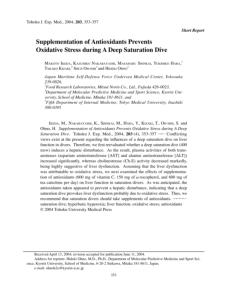

Authors:
Ursula G. Kyle, Ingvar Bosaeus, Antonio D. De Lorenzo,
Paul Deurenberg, Marinos Elia, Jose Manuel Gomez, Berit
Lilienthal Heitmann, Luisa Kent-Smith, Jean-Claude
Melchior, Matthias Pirlich, Hermann Scharfetter, , Annemie
M.W.J. Schols, Claude Pichard
Part II of the ESPEN guidelines reviews data on fat-free
mass (FFM), body fat (BF), body cell mass (BCM), total
body water (TBW), extracellular water (ECW), and
intracellular water (ICW) from various studies involving
both healthy and ill individuals. The findings indicate that
BIA is effective for healthy subjects and patients with
stable water and electrolyte balance when using a
validated BIA equation tailored to age, sex, and race.
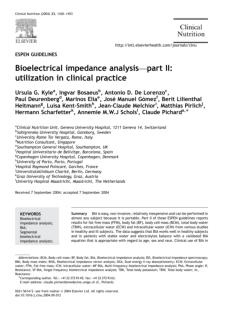

Authors:
Anatoly A. Starkov, Gary Fiskum, Christos Chinopoulos,
Beverly J. Lorenzo, Susan E. Browne, Mulchand S. Patel,
and M. Flint Beal
Reactive oxygen species (ROS) produced by mitochondria
are associated with cell death in various diseases. The
specific sites of mitochondrial ROS production are not
well-defined but are generally believed to be in the
electron transport chain. This study measured hydrogen
peroxide (H2O2) production, respiration, and
Nicotinamide Adenine Dinucleotide Phosphate (NADPH)
reduction in rat brain mitochondria using different
respiratory substrates.
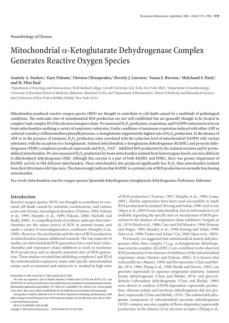

Authors: W Padilla, H B Newton, S Barbosa
This article documents the first case of Weber's syndrome
due to decompression illness in a 55-year-old recreational
scuba diver with a history of a pulmonary cyst. Weber's
syndrome involves oculomotor nerve palsy and
contralateral hemiparesis. Symptoms appeared after a
deep dive exceeding no-decompression limits. The injury
mechanism may involve air gas embolism and
decompression sickness, with pre-existing pulmonary cysts
potentially increasing the risk of complications.
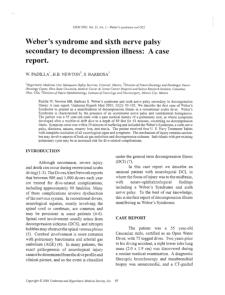

Authors: Earl S. Ford, Harold W. Kohl, Ali H. Mokdad, &
Umed A. Ajani
This study analyzed 1,626 adults to examine the link
between physical activity, sedentary behavior, and
metabolic syndrome. Results indicated that those not
engaging in moderate or vigorous physical activity had
nearly double the odds of metabolic syndrome compared
to those with at least 150 minutes of such activity weekly.
The study concludes that reducing sedentary behavior
and increasing physical activity could significantly lower
the prevalence of metabolic syndrome among adults.
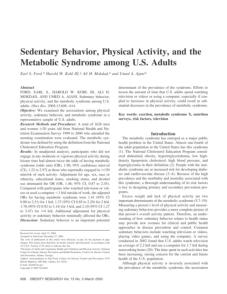

Author: Earl S. Ford
In recent years, major organizations have endorsed the
concept of metabolic syndrome and created working
definitions for it. This study aims to summarize the relative
risk estimates for all-cause mortality, cardiovascular disease,
and diabetes, as reported in prospective studies of general
population samples, using definitions of metabolic
syndrome developed by the National Cholesterol
Education Program (NCEP) and the World Health
Organization (WHO).
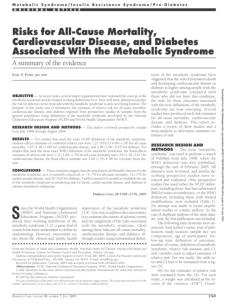

Authors:
Zeljko Dujic, Ivan Palada, Ante Obad, Darko Duplancic, Alf
O. Brubakk, and Zoran Valic
The study investigates whether intrapulmonary shunts,
which can cause neurological damage due to venous
gas emboli, occur after strenuous exercise following a
dive. Eleven healthy military divers performed a dive to 30
meters and mild exercise during the dive, followed by
more intense exercise 40 minutes after surfacing. The
results showed significant venous bubbles but no
intrapulmonary shunting or delayed-onset decompression
sickness. The authors suggest that short, strenuous
exercise after diving may be safe, but further research
with more participants is needed to confirm this.


Authors: JGeorg Kojda, Rainer Hambrecht
IRegular physical activity reduces cardiovascular disease
risk. Exercise promotes vascular remodeling, improving
blood flow. Physical forces activate mechanisms in cells
involving integrins and RhoA (regulating various cellular
processes). Exercise also enhances eNOS expression and
phosphorylation, providing vasoprotective effects. This
process is regulated by factors such as angiogenesis,
arteriogenesis, and antioxidative effects. As a conclusion,
exercise is an effective antioxidant and antiatherogenic
therapy.


Authors: Lars Lind, Nilla Fors, Jan Hall, Kerstin Marttala,
Anna Stenborg
This study evaluated the feasibility and usefulness of three
different techniques for assessing endothelium-dependent
vasodilation in the peripheral circulation within a large-
scale, elderly population-based setting. Conducted as part
of the Prospective Investigation of the Vasculature in
Uppsala Seniors (PIVUS) study, the findings revealed that
all three techniques were feasible for use in a general
elderly population.
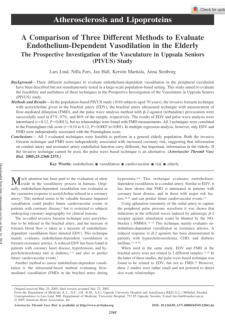

Authors:
James M. Antonini, Annette B. Santamaria, Neil T. Jenkins,
Elisa Albini, Roberto Lucchini
Occupational health officials are concerned about the
neurological effects of manganese in welding fumes. The
behavior of manganese in welding particles after
inhalation is unclear, and its various oxidation states and
solubility may affect biological responses. Therefore,
comprehensive epidemiological studies on welders'
exposure are needed.


Authors:
Stephen R. Thom, Veena M. Bhopale, Omaida C.
Velazquez, Lee J. Goldstein, Lynne H. Thom, and Donald
G. Buerk
The study suggests that hyperbaric oxygen exposure
mobilizes stem cells through a nitric oxide mechanism. In
mice, HBO2 raised stem cell factor by 50% and increased
cells expressing stem cell markers. Bone marrow NO
concentration rose significantly with HBO2. NO synthase
inhibitors prevented stem cell mobilization in mice. Study
concludes that HBO2 stimulates NO synthesis to mobilize
stem cells.
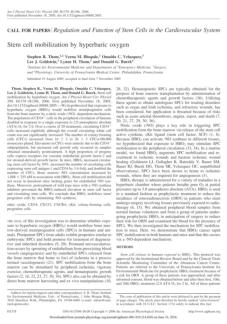

Authors: Jacek Kot, Zdzislaw Sicko
This document provides an overview of the current
treatment protocols for divers suffering from bubble-
related illnesses, such as decompression sickness. It
discusses the standard procedures before recompression,
including normobaric oxygenation, fluid administration,
and patient stabilization, highlighting the potential use of
various pharmacological agents. However, it notes the
lack of solid evidence from randomized controlled studies
regarding their efficacy. Additionally, it references the
recommendations from the Second European Consensus
Conference on Hyperbaric Medicine, suggesting that
these guidelines remain relevant.
.


Authors: Marco Ferrari, Leonardo Mottola, and Valentina
Quaresima
This document reviews and summarizes recent literature
on using near-infrared spectroscopy (NIRS) in exercise
physiology and neuroscience. It explains the principles,
techniques, advantages, limitations, and applications of
NIRS and describes the instrumentation and measurable
parameters associated with this noninvasive technique. It
also highlights the capabilities of NIRS in measuring tissue
oxygen saturation and hemoglobin volume changes and
indirectly assessing brain/muscle blood flow and oxygen
consumption.

Authors: H.D. Van Liew and E.T. Flynn
This document presents research findings on the risk of
decompression sickness (DCS) associated with direct
ascents from saturation dives in humans by analyzing
experimental data to identify a threshold depth at which
the risk of DCS increases significantly. It compares two
models for predicting DCS risk, highlighting that a model
incorporating a threshold provides more accurate
predictions than one without. The study also
recommends using the threshold model in specific
scenarios, such as submarine rescues and discusses the
implications for deeper dives where human data is
lacking.


Authors:
John W. Castellani, Andrew J. Young, Michael N. Sawka
The authors of this paper present the findings of
experiments that investigated the effects of acute and
chronic exertional fatigue on thermoregulatory responses
during cold exposure. They explain the methodology,
results, and conclusions of these studies, highlighting how
prior physical exercise can influence heat loss and core
temperature decline when individuals are subsequently
exposed to cold conditions.
